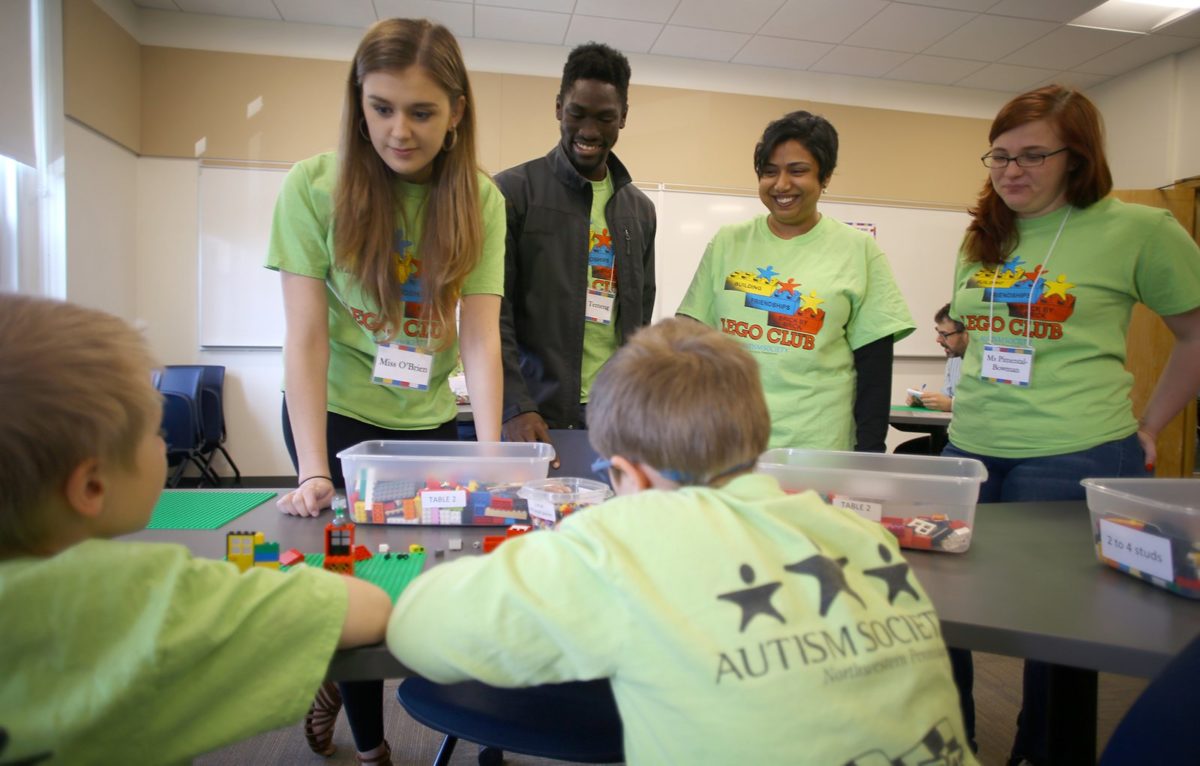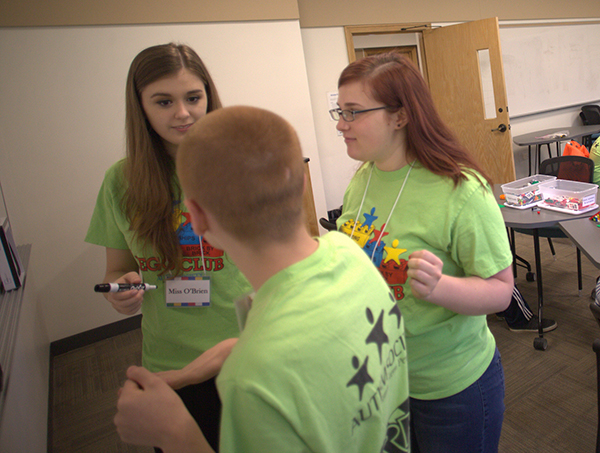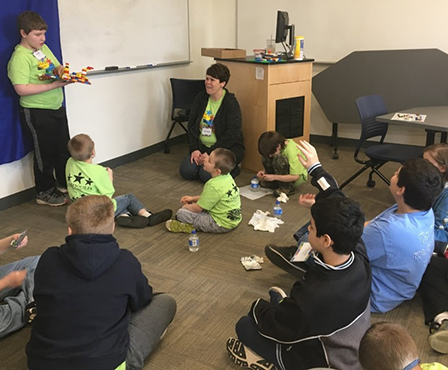Allegheny-Crawford LEGO Social Club Helps Children on the Autism Spectrum Build Social Skills, Friendships
A collaborative program at Allegheny College is helping area children and teens with social difficulties develop their communication skills and build friendships — LEGO brick by LEGO brick.
One Saturday a month during the winter and fall, children from the Penncrest School District gather in the college’s Carnegie Hall for the Allegheny-Crawford LEGO Social Club. They spend 90 minutes building LEGO projects together, interacting with each other, and presenting their work during the program, which is facilitated by Allegheny faculty Monali Chowdhury and students.
“This club is very unique in the way that it uses the platform of LEGO projects to bring kids on the autism spectrum and with other forms of developmental disabilities to a setting where they are building something together,” says Chowdhury, assistant professor of psychology at Allegheny. “Through this platform, children can build some of the social skills and self-confidence that they are limited in, as part of their diagnosis.”
LEGO Club was first brought to this part of Pennsylvania by the Autism Society of Northwestern Pennsylvania in Erie in 2014. The Allegheny-Crawford site was started in February 2018 via Chowdhury’s collaboration with the Autism Society of Northwestern Pennsylvania and professionals of the Penncrest School District, including school psychologist Brittany Adkins.
“We had a definite need in Crawford County for a program like this for students on the autism spectrum.”
Brittany Adkins
School Psychologist
Penncrest School District
Parents in Crawford County can have difficulty finding social activities that children with developmental disabilities will engage with, says Adkins, who reached out to Chowdhury after learning of the professor’s expertise in autism research.
Says Chowdhury: “It is sometimes a struggle, because these children may not feel like they fit in — social interaction is out of their comfort zone, and they may not want to return to activities that are not of interest. But a LEGO-based program is a natural draw. Since it is something that children enjoy, it is easier for them to work on some of the social pieces that they would not have been comfortable with otherwise.”
The Allegheny-Crawford LEGO Social Club held its first meeting in winter 2018 with more than two dozen K–10 students — twice the number that organizers had expected to sign up. Attendance has continued to grow; about 50 children have participated in LEGO Club thus far.
Creating Academic and Community Connections
 Allegheny students serving as research assistants have played a key role in the program’s success, Chowdhury says. They contribute to the planning of the program, assist with preparations each week, and interact directly with children during the Saturday sessions.
Allegheny students serving as research assistants have played a key role in the program’s success, Chowdhury says. They contribute to the planning of the program, assist with preparations each week, and interact directly with children during the Saturday sessions.
Junior Cassie O’Brien has worked with the LEGO social club for two years. The psychology major says the program has given her a new perspective on research.
“All of my past research experiences have been in the lab — giving out questionnaires, assessing data. The social club has really shown me how different research can be. You can get involved and see the aspect that you were researching right in front of you. That’s really powerful,” says O’Brien, who is minoring in communication arts and political science.
Brent Temeng, a 2018 Allegheny graduate, was as an undergraduate research assistant with the club during his senior year. Temeng says he appreciates the opportunity Allegheny gave him to pursue his interest in serving the community through an opportunity outside of his academic major — economics — and his minors — computer science and studio art.
“This LEGO project allowed me to be a part of something — not to just be a student, but be a volunteer for the community I lived in,” Temeng says. “I think that’s a beautiful part about it too.”
Building on a Successful Start
During a session of the LEGO social club, participants first build on their own and then move on to more structured group building time. The program concludes with three children volunteering to talk about projects they brought in from home and field questions from their peers. Chowdhury and the student research assistants say they have seen definite progress in children as they attend more sessions of the club.
 Chowdhury points to participants who initially may have worked at a table by themselves but now have become more likely to work in groups. “They have a conversation — however basic that conversation may be — but still a starting point for that whole social reciprocity piece that is one of our goals,” she says.
Chowdhury points to participants who initially may have worked at a table by themselves but now have become more likely to work in groups. “They have a conversation — however basic that conversation may be — but still a starting point for that whole social reciprocity piece that is one of our goals,” she says.
That interaction helps to foster spontaneous teamwork and reinforce the importance of communication and problem solving among participants, Chowdhury says. Neurotypical siblings and friends also can attend the club, which provides opportunities for peer mentoring.
The questions that participants ask each other during the sharing session also have become less formulaic and more genuine, O’Brien says. For example, children may at first ask only basic questions such as “How long did that take to build?” But as they become more comfortable, O’Brien says the inquiries have reflected a deeper level of interaction — such as “What does that piece do?” or “How did you think of that idea?”
And the stories that children share about their projects show an immense amount of creativity and abstract thought, Chowdhury says, attributes sometimes not associated with children on the autism spectrum.
 “Even as a scientist who has been involved in autism spectrum work for years, what has impressed and amazed me is the level of imagination in the stories behind the models that the children tell,” she says.
“Even as a scientist who has been involved in autism spectrum work for years, what has impressed and amazed me is the level of imagination in the stories behind the models that the children tell,” she says.
Adkins, the Penncrest school psychologist, says that “the turnout has been awesome and that she has been “really pleased with the early friendships that are blooming.”
Adkins also notes that parents stay in a waiting area during the club. They “find community with one another, which is a hidden benefit of the program,” she says. Some even have arranged LEGO-building playdates outside of the club for their children — supporting the goal of fostering friendships.
Chowdhury says that evidence of the program’s success includes qualitative feedback from parents. For example, parents have shared that their children tell them they “won’t miss” a session of the club and choose it over other activities. Another parent shared that “LEGO Club has helped us become connected with the thoughts of our bright boy and for that, my family is eternally grateful.” Quantitative data collection continues this semester in the form of structured observation of the children.
This assessment research data will help organizers improve the club in the future. “Clearly, there’s a need for the program as evidenced by the response we have received from families, and we’re looking forward to building on the work we started,” Chowdhury says.
Appropriate permissions have been obtained to use images of Allegheny-Crawford Lego Social Club members.